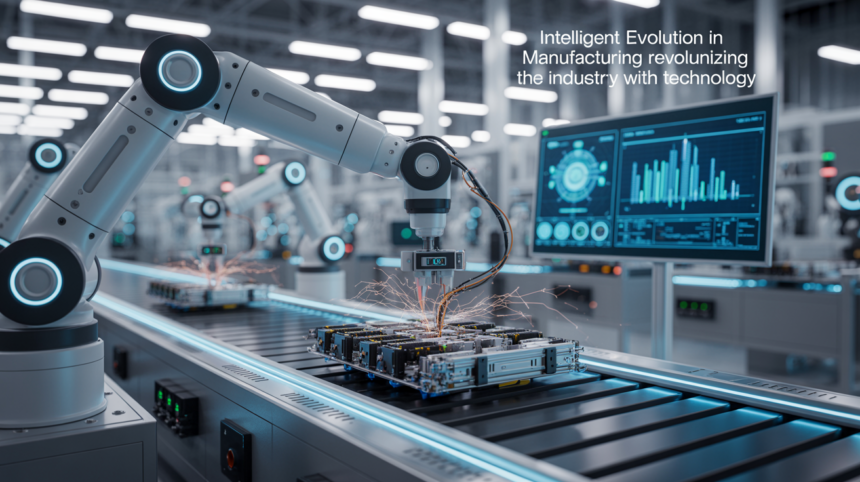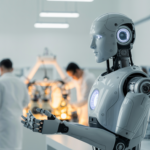When you think about the manufacturing industry, what comes to mind? Perhaps it’s images of large, noisy factories with rows of machines working in sync. Now imagine that scene evolving machines that think, adapt, and learn. This is the essence of intelligent evolution in manufacturing.
It’s not just about adding automation or throwing artificial intelligence (AI) into the mix; it’s a complete transformation of how factories operate, enhancing collaboration, speed, and efficiency in ways never before possible.
In recent years, the manufacturing floor has undergone a monumental shift. Machines no longer simply follow preset commands they interact with their environment, predict failures, and adapt to changing conditions. This intelligent evolution has taken the industry from a mechanical world of simple automation to a dynamic, ever-learning environment where human workers and machines collaborate more effectively than ever before.
In this post, we’ll break down what intelligent evolution in manufacturing means, its importance, how it works, and the major impact it’s having on industries worldwide.
The Importance of Intelligent Evolution in Manufacturing
Why should we care about intelligent evolution in manufacturing? Well, this shift is revolutionizing the way products are made and how businesses operate. It’s helping companies:
- Increase Efficiency: Predictive analytics and AI can optimize production lines, ensuring that machines run at their best.
- Improve Quality Control: AI systems can analyze products in real-time, detecting defects faster and more accurately than the human eye.
- Reduce Costs: Automation reduces the need for manual intervention, cutting down on labor costs and minimizing errors.
- Enhance Flexibility: With intelligent machines, manufacturers can quickly adapt to new product designs or changes in demand without overhauling the entire production process.
By adopting this cutting-edge technology, manufacturers are not only improving productivity they are reshaping the entire landscape of industrial work.
What is Intelligent Evolution in Manufacturing?
Intelligent evolution refers to the integration of advanced technologies like AI, machine learning, and robotics into manufacturing processes. These technologies allow machines to think, predict, and adapt on their own. The goal is not just automation but creating an ecosystem where machines, humans, and systems work in harmony.
The idea behind intelligent evolution is to move beyond traditional automation, which simply mechanizes repetitive tasks, to a new paradigm where systems are smart, responsive, and capable of learning from data. It’s about creating a manufacturing environment that evolves and improves over time through the application of AI and automation.
Key Technologies Driving Intelligent Evolution
Several emerging technologies are fueling this intelligent evolution in manufacturing. Let’s take a look at some of the most important ones:
1. Robotics and Automation
Robots have been a part of manufacturing for decades, but today’s robots are much more sophisticated. Modern robots use AI to perform tasks with greater precision, flexibility, and adaptability. They can work alongside humans, learning from their environment and optimizing their movements.
For example, collaborative robots (cobots) are designed to work safely next to human workers, helping them with repetitive tasks while also learning and adapting to human movements. This collaboration increases efficiency and reduces the chances of human error.
2. Artificial Intelligence (AI) and Machine Learning
AI and machine learning play a central role in intelligent evolution. These technologies allow machines to analyze large datasets, detect patterns, and make real-time decisions. In manufacturing, this means predictive maintenance, where AI predicts when machines are likely to fail and schedules maintenance accordingly, preventing costly downtime.
Machine learning also enhances quality control. For instance, AI can analyze product images to spot defects that would be nearly impossible for a human inspector to detect.
3. Internet of Things (IoT)
The IoT refers to the network of interconnected devices that communicate and share data. In manufacturing, this means that machines, sensors, and devices can exchange information, giving manufacturers a clearer picture of the entire production process. By collecting data from IoT-enabled machines, manufacturers can track performance in real time, making adjustments as needed to optimize the production process.
4. Big Data and Analytics
With the advent of big data, manufacturers now have access to more information than ever before. Analytics tools sift through massive amounts of data to extract actionable insights, helping businesses optimize everything from inventory management to supply chain logistics.
In the context of intelligent evolution, big data allows manufacturers to predict demand, optimize production schedules, and even tailor products to meet individual customer preferences.
How Does Intelligent Evolution Work in Practice?
Now that we understand the technologies driving intelligent evolution, let’s explore how these tools are integrated into manufacturing environments. The process of implementing intelligent evolution is not just about adopting new technology; it’s about creating a smart, interconnected ecosystem.
1. Data Collection
The first step in intelligent evolution is collecting data. IoT sensors installed on machines and equipment gather information about machine performance, environmental conditions, and production processes. This data is then sent to a central system for analysis.
2. Predictive Maintenance
With AI and machine learning, manufacturers can predict when equipment is likely to fail. Predictive analytics can analyze patterns in the data and forecast potential breakdowns before they happen. This allows companies to perform maintenance only when necessary, reducing unnecessary downtime and repair costs.
3. Automated Decision-Making
Once data is collected, AI systems can make decisions about how to optimize the production process. These decisions may include adjusting machine settings, rerouting products, or even changing the production schedule. The goal is to make real-time decisions that improve efficiency, reduce waste, and maintain quality.
4. Collaborative Work Environments
In intelligent manufacturing environments, machines and humans work together more closely than ever before. Humans oversee the processes, making strategic decisions, while machines handle repetitive tasks. This collaboration increases productivity and allows workers to focus on higher-level tasks that require problem-solving and creativity.
The Benefits of Intelligent Evolution in Manufacturing
Adopting intelligent evolution in manufacturing comes with numerous advantages. These benefits extend beyond increased efficiency they can transform the way businesses operate at every level.
1. Increased Productivity
With automation and AI, manufacturing processes can be sped up without sacrificing quality. Robots can work around the clock, performing tasks more efficiently than human workers. This increase in productivity translates to higher output and reduced production costs.
2. Cost Reduction
The integration of predictive maintenance reduces downtime, while AI-driven analytics can optimize the use of resources, reducing waste. Over time, this leads to significant cost savings for manufacturers.
3. Improved Quality
AI-driven quality control ensures that every product meets the highest standards. By using advanced algorithms to detect defects, manufacturers can identify and correct issues early in the production process, leading to better products and fewer returns.
4. Enhanced Flexibility
Intelligent systems can adapt to changes in demand or production schedules. For example, if there’s a sudden increase in demand for a particular product, the system can adjust the production process in real time to accommodate the change.
5. Safer Work Environments
Intelligent evolution doesn’t just improve productivity it also improves workplace safety. Robots and AI systems can handle dangerous tasks, reducing the risk of injury to human workers. In addition, AI systems can monitor workplace conditions to identify potential hazards before they become serious problems.
Mistakes to Avoid When Implementing Intelligent Evolution
While the benefits of intelligent evolution are clear, it’s important to avoid common mistakes when integrating these technologies into manufacturing environments.
1. Underestimating the Complexity of Integration
Integrating advanced technologies like AI, robotics, and IoT can be complex and requires careful planning. Don’t rush into the process without a clear strategy for how these technologies will work together.
2. Neglecting Employee Training
Even the most advanced systems require skilled workers to operate them. Ensure that employees are properly trained on how to use new technologies to maximize their effectiveness.
3. Ignoring Data Security
With the increased reliance on data comes the need for robust data security measures. Protect sensitive manufacturing data from cyber threats to avoid disruptions to your operations.
Intelligent Evolution vs. Traditional Manufacturing: A Comparison
To understand the full impact of intelligent evolution, let’s compare it with traditional manufacturing processes:
| Feature | Traditional Manufacturing | Intelligent Evolution |
|---|---|---|
| Automation Level | Limited automation with human oversight | High automation with AI and robots |
| Decision-Making | Primarily human-driven | AI-driven with real-time adjustments |
| Flexibility | Low adaptability to changes | Highly adaptable to demand changes |
| Maintenance | Reactive maintenance | Predictive maintenance |
| Data Usage | Minimal data analysis | Big data and analytics for optimization |
Conclusion
The concept of intelligent evolution in manufacturing is not just about adding new technology it’s about transforming how we think about production. By embracing AI, robotics, IoT, and big data, manufacturers can optimize operations, reduce costs, improve quality, and create safer, more flexible work environments.
As the industry continues to evolve, the potential for growth and innovation is endless. So, if you’re not already embracing intelligent evolution, it’s time to start thinking about how these technologies can reshape your manufacturing process for the better.






